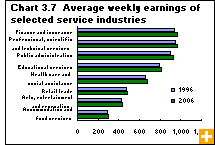Common menu bar links
Are average wages higher in services?
Archived Content
Information identified as archived is provided for reference, research or recordkeeping purposes. It is not subject to the Government of Canada Web Standards and has not been altered or updated since it was archived. Please contact us to request a format other than those available.
Working the oil fields is where the money is. Average wages in the mining, oil and gas industry stood at $1,315 per week in August 2006—higher than the average in any other industry, even service industries that put a premium on education and high-tech skills.
Canadians working in goods-producing industries bring home paycheques that are, on average, 35% fatter than those in the services sector. However, earnings within the services sector vary greatly. For instance, average weekly earnings in service industries that require extensive training or education—such as management of companies and enterprises; professional, scientific and technical services; public administration; and finance and insurance—range from $941 to $965, compared with $937 in the goods-producing sector as a whole.
Employees in other key service industries—including education, wholesale trade and transportation—make from $780 to $880 per week, somewhat more than the $696 average for the services sector overall. Average earnings across this sector are pulled down by the low wages paid in a few industries, i.e., accommodation and food services; arts, entertainment and recreation; and retail trade. Restaurant workers, who average $317 weekly, are among the lowest paid in the economy. Performing artists earn about $428 per week; retail salespeople, about $482.
From 1996 to 2006, wages in the services sector grew 29%, slightly faster than those in goods-producing industries, 25%. Workers in most service industries saw similar wage increases, but those in accommodation and food services, retail trade, and health care saw their earnings grow 32% to 39% over that decade.



